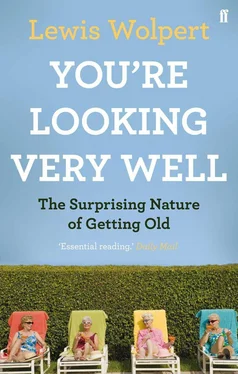There are some 820,000 people in Britain with dementia, about half of whom suffer from Alzheimer’s disease. Generally Alzheimer’s is diagnosed in people over 65 years of age, although the less-prevalent early-onset Alzheimer’s can occur much earlier. The disease in those in the 30 to 40 age group is rare, and even rarer are cases due to a genetic defect that results in it occurring in those as young as 16. There are estimates that there are over 20,000 younger people with dementia in the UK. The Alzheimer’s Society estimates that the disease costs Britain £ 17 billion a year. Families caring for patients save the government £ 6 billion a year. It is expected that a further one million people will develop dementia in the next 30 years, and it is projected that expenditure on long-term care services for older people with dementia is set to increase from about £ 4.6 billion in 1998 to £ 10.9 billion in 2031. It is claimed that 5.3 million Americans are living with the disease; a new case develops every 70 seconds. An estimated 27 million people worldwide had Alzheimer’s in 2006; this number may quadruple by 2050.
Dementia causes problems with at least two brain functions, memory loss along with impaired judgement and language. Dementia can make an individual not just confused and unable to remember people and names, but also experience changes in personality and social behaviour. Some causes of dementia are treatable and even reversible, but early diagnosis is important so that treatment can begin before symptoms worsen. If the diagnosis is a dementia that will progressively deteriorate over time, such as Alzheimer’s disease, early diagnosis also gives a person time to plan for the future while he or she can still participate in making decisions. A quite simple test has been developed for detecting early stages of Alzheimer’s that would require further investigation. It is a two-page questionnaire, and has ten tests that include remembering a phrase, doing sums, identifying parts of a man’s suit, and drawing the time on a blank clock face. A quite different early diagnosis may be based on examining the fluid in the spine for the proteins that are responsible for the disease.
The disease is named after Alois Alzheimer, who was born in 1864 in Germany and studied medicine. He then worked at the Municipal Mental Asylum in Frankfurt, and later moved with Emil Kraepelin to the Max Planck Institute in Munich. He died in 1915. His first patient with the disease that was eventually to carry his name was Auguste D., a 51-year-old woman. She presented with jealousy of her husband, paranoia, memory impairment and, towards the end of her life, loud screaming. On 3 November 1906 Alzheimer presented the results obtained from studying the structure of the cellular organisation of her brain which included several fibrils—amyloid protein—and numerous small abnormal foci due to cell death. It was his mentor Emil Kraepelin who gave the disease his name in the eighth edition of his textbook in 1910.
At the early stages of Alzheimer’s disease the most commonly recognised symptom is memory loss, such as difficulty in remembering recently learned facts. Typically there is misplacing and losing objects and repeatedly asking the same questions. The sufferer has difficulty in finding words to complete a sentence and comprehension is poor, as is doing complex motor tasks. There are also non-cognitive symptoms—delusions, depression and anxiety, and verbal and physical aggression. Patients can be very difficult. One patient hit his wife, and did not understand the difference between night and day—he could go to bed and get up thirty times in a night. Median survival is about five years. Apathy can be observed at an early stage, and remains a most persistent symptom. Despite the loss of verbal language abilities, patients can often understand and return emotional signals. A remarkable finding is that facial asymmetry in men results in an increased mental decline in the years before death.
Although it may not be easy, people with Alzheimer’s disease can live quite full and productive lives. Taking time to prepare for the challenges that come as the disease progresses will ease the difficult transitions. Well-known personalities such as Bernard Levin and Iris Murdoch had Alzheimer’s, and Terry Pratchett has a special form. He has problems recognising visual signals and can take minutes to tie a tie, but his talking is fluent, though his reading can be confused. Watching him and others with Alzheimer’s on a BBC TV programme, there was nothing in the way they talked or behaved which gave any indication of abnormality. But they could not remember what had happened recently, and one could not copy a geometrical design. Pratchett has said he ‘would eat a dead mole’s arse’ if it would cure him. He wants to be able to choose when to die. The TV journalist John Suchet has described the dementia of his wife, which started when she was 61. She now will pile dirty plates on top of clean ones, and repeatedly flush the toilet when not using it. Her memory is poor. Husbands and wives are six times more likely to get dementia if their spouse has it. This could be related to the stress of caring or living with someone in that condition.
Andrea Gilleas describes in her book Keepers the severe problems of looking after a mother-in-law with Alzheimer’s. A recent play, Really Old, Like Forty Five by Tamsin Oglesby, takes place when Alzheimer’s has reached epidemic proportions. A family are trying to deal with an elderly lady member suffering from the disease. There are, unusually, comic elements like robot nurses, midway between cat and carer, and bizarre plans to help by government officials.
Some cases of early-onset Alzheimer’s may be caused by a number of different gene mutations. These mutations cause the formation of abnormal amyloid, fibrous protein aggregates in the brain. One of the ways proteins can have severe negative effects is by becoming an amyloid. Many different proteins can do this, developing sticky elements which enable them to stick together and form sometimes deadly fibres. The amyloid appears to bind to the neurones with a prion protein that is associated with BSE and Creutzfeldt-Jacob disease. The amyloid accumulation interacts with a tau protein which gets into nerve cells and causes the formation of aggregates of particles, leading to the tangles which cause the death of nerve cells. Recent studies correlated levels of the tau and amyloid proteins in the cerebrospinal fluid with changes in cognition over time, and found that changes in these two protein levels may signal the onset of mild Alzheimer’s. This is a significant step forward in developing a test to help diagnose the early stages of Alzheimer’s disease.
One predisposing genetic risk factor is related to the APOE genes that code for proteins that help carry cholesterol in the bloodstream. APOE comes in several different forms; APOE4 occurs in about 40 per cent of all people who develop late-onset Alzheimer’s and is present in about 25 to 30 per cent of the population. People with Alzheimer’s are more likely to have an APOE4 gene; however, many people with Alzheimer’s do not have it. There is concern that a genetic test for this gene could lead to excessive anxiety. This is particularly true of individuals whose parents have suffered from the disease. A study of such individuals tested for the APOE gene did not find any serious anxiety in those who tested positive, but none suffered from anxiety or depression prior to the test. In addition, they were given counselling and followed up for a year. A surprising feature of the gene is that those who have it are more intelligent.
There is no cure for Alzheimer’s, but a few drugs such as Aricept can improve memory a bit, and have general benefits including improving alertness and motivation for those in the early stages. It may take some months for there to be a noticeable improvement or slowing down of memory loss. Claims that the anti-histamine drug Dimedon had positive effects have now been shown to be wrong. Non-drug treatments include reality orientation with clocks, boards and newspapers; reminiscence therapy recalling past events like marriage; cognitive stimulation therapy like physical and mental games; and music therapy. There is evidence that exercise and a diet rich in fruit and vegetables lowers the risk of getting Alzheimer’s. A good education also lowers the risk.
Читать дальше












